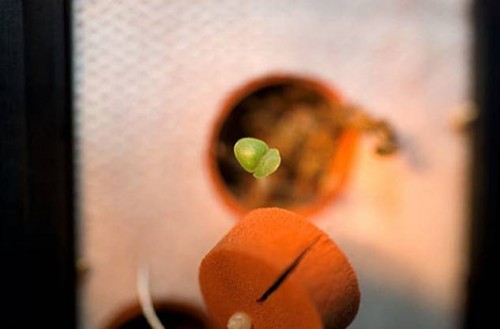Tag archives: science
Lucky physicists, runways renamed as magnetic poles shift, what happened to the Zuma spacecraft?

Lucky ping: the invention of the microwave oven. (Courtesy: Perimeter Institute)
By Hamish Johnston
“In the fields of observation, fortune favours the prepared mind,” is a quote attributed to Louis Pasteur and it encapsulates the role of luck in scientific investigation. The Perimeter Institute for Theoretical Physics in Canada has put together a list of eight scientific breakthroughs that benefited from a little luck. Examples include Ernest Rutherford and colleagues measuring alpha-particle backscattering when they were really interested in how the particles travelled through the target – which resulted in the discovery of the atomic nucleus. But my favourite is how the microwave oven was invented, as described above.
View all posts by this author | View this author's profile
The physics of sperm: the movie
By James Dacey
Luke Skywalker et al. re-entered the public imagination recently with the release of the trailer for Star Wars: the Last Jedi. But where that movie takes you on a galactic adventure, a new short web film by the Wyss Institute in the US takes you on a swashbuckling tour of the microscopic – tracking animated sperm on a mission to fertilize an egg.
The Beginning is based on collaborative work between a pair of researchers at the Wyss Institute for Biologically Inspired Engineering at Harvard University. Founding director Don Ingber teamed up with the biophysicist/professional animator Charles Reilly to seek an atomic-level understanding of sperm movement. Combining molecular dynamics simulations with film animation software, they have visualized how a sperm tail moves based on scientific data.
View all posts by this author | View this author's profile
Debating UK science

Science and the ballot box. (Courtesy: iStockphoto/stocksnshares)
By Michael Banks
Yesterday evening I went to the Royal Society in London to hear what the three main political parties in the UK have to say about science. The event was held because in May voters in the UK will be heading to the polls to choose their next government. The three parties had therefore sent their main science representatives to the Royal Society to spell out their intentions.
Chairing the debate was space scientist Maggie Aderin-Pocock of University College, London. She had the unenviable task of keeping science minister Greg Clarke (Conservative), Liberal Democrat science spokesperson Julian Huppert, and shadow universities, science and skills minister Liam Byrne (Labour) in check. For non-UK readers, it’s worth pointing out that the Conservatives have been in coalition with the Liberal Democrats since 2010.
View all posts by this author | View this author's profile
‘Mile-high’ physics

By Tushna Commissariat at the APS March Meeting in Denver
The city of Denver, Colorado has been invaded…or so I am sure the locals will feel over the next few days, as more than 9000 physicists from all over the world have arrived to take part in the APS March Meeting. I have been here in the “Mile-high city” of Denver – so nicknamed thanks to its official elevation that is exactly one mile or 5280 feet above sea level – since Sunday morning, and physics is the talk of the town as everyone descends upon the Colorado Convention Center (pictured above).
As always, there is a wide variety of interesting talks, sessions and press conferences over the next few days and I would have to clone myself multiple times to get around to all of them. Talking about cloning, though – I have just been to my first session, where Stanford researcher Patrick Hayden was taking about quantum information and asking whether or not it could be cloned in space–time. I will be speaking with Hayden later in the day, so watch this space if you would like to know more.
Cress on the Moon, more physics books, a radioactive ‘foot’ and more

A small green sprout of cinnamon basil, growing on board the International Space Station in 2007. (Courtesy: NASA)
By Tushna Commissariat
Early this week, a story in the Telegraph caught our eye – NASA is planning on sending turnip, cress and basil seeds to the Moon to germinate them! This is most definitely not the first time that plants have been grown beyond the realms of Earth. Indeed, potatoes were grown on board during a 1995 Space Shuttle mission and many experiments involving germinating seeds were done on the International Space Station. The goal of these studies was to understand the effects of microgravity on plant growth. But now, NASA plans to take this one step further in 2015 with their Moon Express mission, which will include the Lunar Plant Growth Chamber that will carry seeds and enough air and nutrients to allow the seeds to sprout and grow. Will fresh salad be on an astronaut’s menu soon?
Pop-culture mathematics
By Tushna Commissariat
Earlier this week I went to hear a talk about mathematics…and The Simpsons. That’s right, I am indeed referring to the long-running animated TV show that is a satirical parody of middle-class American life and its unexpected but concrete mathematical vein. Surprising as it may sound, some of show’s scriptwriters have degrees in maths and physics, meaning that some very advanced concepts, problems and ideas from all of 20th-century mathematics and physics are littered around many of the show’s 535 episodes. Regular Physics World readers will have already seen that we have released the shortlist for our Book of the Year 2013 and that physicist and science communicator Simon Singh’s latest offering – The Simpsons and their Mathematical Secrets – is one of 10 books on the list. I had the happy job of reading and reviewing Singh’s book for our “Between the lines: Christmas special” section in the December issue of the magazine.
View all posts by this author | View this author's profile
Hubble – one million and going strong
By Tushna Commissariat
I have already raved on about the awesomeness of the Hubble Space Telescope in my blog entry about its 21st anniversary in April this year. Now, the telescope has crossed yet another milestone – on Monday 4 July the Earth-orbiting observatory logged its one-millionth science observation! The image above is a composite of all the various celestial objects ranging through stars, clusters, galaxies, nebulae, planets, etc that Hubble has catalogued over the years. Click on the image for a hi-res version. [Credit: NASA, ESA and R Thompson (CSC/STScI)]
The telescope has had a significant impact on all fields of science from planetary science to cosmology and has provided generations with breathtaking images of our universe ever since it was launched on 24 April 1990 aboard Discovery’s STS-31 mission.
Hubble’s counter reading includes every observation of astronomical targets since its launch. The millionth observation made by Hubble was during a search for water in the atmosphere of an exoplanet almost 1000 light-years away from us. The telescope had trained its Wide Field Camera 3, a visible and infrared light imager with an on-board spectrometer on the planet HAT-P-7b, a gas giant planet larger than Jupiter orbiting a star hotter than our Sun. HAT-P-7b has also been studied by NASA’s Kepler telescope after it was discovered by ground-based observations. Hubble now is being used to analyse the chemical composition of the planet’s atmosphere.
“For 21 years Hubble has been the premier space-science observatory, astounding us with deeply beautiful imagery and enabling ground-breaking science across a wide spectrum of astronomical disciplines,” said NASA administrator Charles Bolden. He piloted the space shuttle mission that carried Hubble to orbit. “The fact that Hubble met this milestone while studying a far away planet is a remarkable reminder of its strength and legacy.”
Hubble has now collected more than 50 terabytes – the archive of that data is available to scientists and the public at http://hla.stsci.edu/
And take a look at this Physics World article by astrophysicist Mark Voit where he looks at the most iconic images Hubble has produced over the years – Hubble’s greatest hits
The NASA video below was created last year for the 20th Hubble anniversary celebration and tells you how you could send a message to Hubble that will be stored in its archive.
View all posts by this author | View this author's profile
